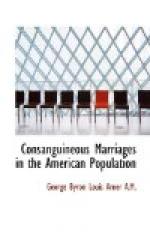[Footnote 101: Biometrika, vol. ii, p. 373.]
But even if it were true, as is very improbable, that parents of adult children are more alike than first cousins, it would still be likely to follow that first cousins who married would be more alike than first cousins in general. A certain degree of resemblance is undoubtedly necessary to complete fertility: husband and wife must be physically compatible, and must both enjoy a certain degree of health and physical strength. These facts are admitted by all, but it does not follow that resemblance beyond a certain point is not in itself detrimental.
Professor Pearson’s own experiments in this line, however, do not give consistent results, for in correlating eyecolor with fertility, heterogamy seems to increase fertility. The highest average fertility (4.57) is in those cases where the father is dark-eyed and the mother light-eyed, while the lowest is where both parents have blue-green or gray eyes.[102]
[Footnote 102: Phil. Trans. of the Royal Society, vol. 195 A, p. 150.]
In a recent study an attempt has been made to measure the coefficient of correlation between cousins.[103] In the characteristics of health, success, temper and intelligence the coefficients ranged between .25 and .30. These values differ but little from those found to obtain for the resemblance between avuncular relatives for eye color (.265), or between grandparent and grandchild for the same characteristic (.3164).[104] Positive results were also found, with one doubtful exception, for the occurrence of insanity and tuberculosis in cousins. The writer concludes: “The grandparent, the uncle and aunt, and the cousin are on practically the same footing with regard to relationship or intensity of kinship as measured by degree of likeness of character; and it seems probable that any scientific marriage enactments would equally allow or equally forbid marriage between grandparent and grandchild, uncle and niece, aunt and nephew, and between first cousins."[105]
[Footnote 103: Elderton and Pearson, “On the Measure of the Resemblance of First Cousins.” Eugenics Laboratory Memoirs IV. Reviewed in Br. Med. Journal, Feb. 15, 1908.]
[Footnote 104: Phil. Trans. of the Royal Society, vol. 195 A, p. 106.]
[Footnote 105: Elderton and Pearson, op. cit.]
As we should expect the resemblance between near relatives has been found to be much greater. From a measurement of from 4000 to 4886 pairs, the average correlation of the characteristics of stature, span, forearm length and eyecolor between parent and child was .4695. By similar computations and measuring the same characteristics, the fraternal correlation was found to be .508.[106] From measurements of a greater variety of characteristics in school children the mean fraternal correlation was .539.[107] In athletic power the coefficient was still higher, .72 between brothers, .75 between sisters and .49 between brothers and sisters. Measurements of mental characteristics—vivacity, assertiveness, introspection, popularity, conscientiousness, temper, ability and handwriting proved to be as easily correlated, the mean coefficients being; brothers, .52, sisters .51, brothers and sisters .52.[108]




